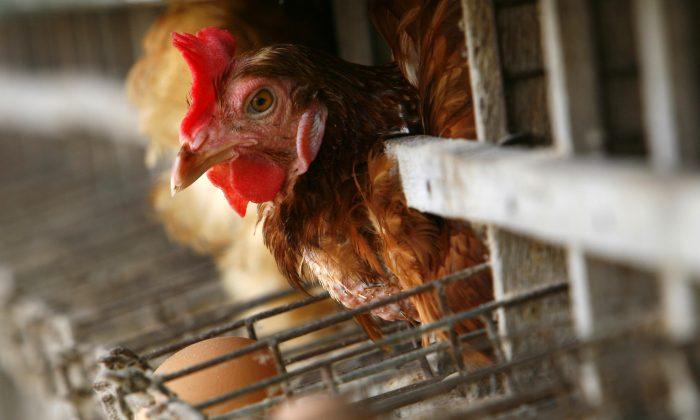For the first time, researchers have linked food-borne illnesses to the foods that most often carry them, and ranked them according to their economic impact. They discovered that of the food pathogens that cost society the most money, half are found in meat products.
The food and food contaminant combination that causes the most economic damage is campylobacter in poultry. Campylobacter sickens more than 600,000 people and costs the U.S. $1.3 billion a year. In second place is toxoplasma in pork, which costs an estimated $1.2 billion a year.
The Washington Post reports:
“Salmonella was flagged as the bacterium that causes the most disease overall, resulting in $3 billion in annual costs ... The federal government estimates that one in six Americans gets sick every year from food-borne illnesses.”
An estimated one in six Americans gets sick every year from contaminated food. Sometimes this results in a 24-hour bout of diarrhea and vomiting that clears on its own, but in other cases food-borne pathogens can lead to organ failure, paralysis, neurological impairment, blindness, stillbirths and even death
Despite the fact that over 100,000 people are hospitalized from food-borne illnesses each year in the United States, and 3,000 die, very little was actually known about which foods are the most risky-- until now.
A report from the University of Florida’s Emerging Pathogens Institute reveals which pathogen-food combinations are most likely to make you sick, and overwhelmingly the data points to tainted meats, including poultry, pork and deli meats, as the prime culprits.
My Personal Experience this Easter
A day after Easter my sister Janet, who started my medical practice with me in 1985 and is now the senior editor of this newsletter, called me to tell me she was concerned about her 12-year-old son who was really very sick.
It turns out he had some very large Fannie Mae chocolate Easter Eggs the past two days that well-intentioned grandparents had given him in Easter baskets. Unfortunately it was a major sugar overload for him and he got violently sick the following week as a result.
We did some blood work to rule out anything serious and confirm that he was stable, and the lab results came back just fine. He responded quite well with fasting, rest and ginger for weeks of lingering intermittent nausea.
It was VERY clear that the sugar assault had temporarily devastated his immune system and he became susceptible to getting an infection. What my nephew and many of you likely fail to appreciate is that most of these food-borne infections will ONLY get you if the rest of your diet is not optimized, ESPECIALLY when you are eating sugar.
You can radically reduce your risk of any of the food-borne infections that I will discuss below if you successfully avoid sugar.
This unfortunate incident was a significant learning experience for my nephew. He has been home schooled his entire life and this was a real world teachable moment that will powerfully instruct him in the value of avoiding sugar in the future.
Which Meats and Contaminants are Most Likely to Make You Sick?
In order to one day circumvent the widespread food poisoning outbreaks that occur on a regular basis, the U.S. Food and Drug Administration (FDA) and the U.S. Department of Agriculture (USDA) need to know which foods make people sick most often.
This is exactly what the University of Florida report revealed, in the hopes that it will “allow food safety regulators to target scarce public dollars toward the biggest food safety problems and find solutions to protect consumers.”
After reviewing data on the 14 pathogens that cause 95 percent of total cases of food-borne illness, the top-ranked pathogen-food combinations most likely to make you sick were poultry, pork and deli meats.
- Poultry tainted with Campylobacter: 600,000 cases of illness, 7,000 hospitalizations annually
Poultry was found to cause more food-borne disease than any other food, amounting to $2.4 billion in costs of illness. The primary bacteria to blame were Campylobacter, followed by Salmonella.
Chickens and turkeys normally harbor Campylobacter in their digestive tracts without becoming ill. Antibiotics routinely given to the birds in confined animal feeding operations (CAFO’s) don’t completely eliminate Campylobacter from the birds’ intestinal tracts, so the surviving bacteria are the tougher ones that have resisted being killed off by the antibiotics. Those bacteria proliferate in the birds and end up being passed on to you—along with their antibiotic-resistance.
Campylobacter bacteria are found on chicken carcasses in slaughterhouses and in commercial poultry products—including on the outside of poultry packaging—where they can easily infect you, your children, or your pets.
The only way to determine if you have Campylobacter versus another food-borne infection, such as Salmonella, is by having your stool cultured.
If you are found to have Campylobacter infection, you will likely recover on your own without treatment within two to five days, providing you drink plenty of fluids to prevent becoming dehydrated. In rare cases, Campylobacter can cause far more serious problems. A type of arthritis, as well as neurological problems, have been reported secondary to Campylobacter poisoning, although these reactions are not common.
One serious complication of Campylobacter is Guillain-Barré (G-B) syndrome, a relatively rare neurological disease characterized by progressive weakening of your muscles. Although other bacteria can trigger G-B syndrome, Campylobacter is thought to be responsible for nearly half of all G-B cases in the United States.
- Pork contaminated with Toxoplasma: 35,000 cases of illness, 2,000 hospitalizations annually
Toxoplasma gondii is the parasite responsible for toxoplasmosis and one of the most common parasites in the world. It’s typically associated with coming into contact with contaminated cat feces but the new report states the CDC now estimates that 50 percent of toxoplasmosis is food-borne.
The authors state:
“ … foodborne toxoplasmosis causes 327 deaths annually, second only to Salmonella.”
Toxoplasma can be spread by eating or handling contaminated undercooked meat, fruits and vegetables, or drinking contaminated water. The report noted that pork, followed by beef, was most likely to transmit the parasite.
In most healthy people toxoplasmosis infection is asymptomatic, causing no symptoms because your immune system keeps the parasite from causing illness. In fact, in the United States it’s estimated that 23 percent of the population has been infected with toxoplasma, and according to the Centers for Disease Control and Prevention up to 95 percent of some populations around the world have been infected.
When symptoms do occur they may include swollen glands, fatigue, muscle pain, fever, sore throat and a rash. In pregnant women, however, toxoplasmosis that is newly acquired can cause miscarriage, premature births, and severe illness and blindness in newborns.
This is why it’s commonly advised that pregnant women (and those with compromised immune systems) should take extra precautions and avoid coming into contact with cat feces, cat litter or potentially contaminated food, soil or water.
It should be noted, however, that if you have been exposed to the parasite in the past (even if you had no symptoms) this will provide immunity so you can’t become infected again.
- Deli meats tainted with Listeria: 600 hospitalizations and more than 100 deaths annually
The CDC estimates that 2,500 Americans become seriously ill from listeria each year and among these, 500 will die. You can get listeriosis (the illness from ingesting Listeria) from eating raw contaminated vegetables, meats and dairy products. Although cooking generally kills listeria, the report found deli meats to be the most risky choice, as ready-to-eat foods like these can become contaminated after cooking during the packaging process.
According to the report, the risks associated with deli meats from the supermarket deli are five times higher than for prepackaged deli meats. Other listeria outbreaks have been linked to soft ripened cheeses made from unpasteurized milk, particularly queso fresco, a fresh Mexican cheese.
The FDA often warns against drinking raw milk partly because it could contain listeria. But how many cases of the 2,500 a year actually come from raw milk?
According to the FDA and the CDC, from 1998 to May 2005 there were 45 outbreaks of food-borne illness that implicated unpasteurized milk, or cheese made from unpasteurized milk. These outbreaks accounted for 1,007 illnesses, 104 hospitalizations, and two deaths.
This works out to 144 cases a year. And that is assuming that EVERY person who got sick from raw milk that year got sick from listeria, which is highly unlikely.
So it is likely far fewer than 144 people a year who have gotten listeriosis from raw milk. The remainder of the 2,500 illnesses a year are then coming from, as the report noted, primarily deli meats. Hot dogs, refrigerated pre-prepared meat spreads, and pre-made meat and seafood salads have also been implicated in listeria outbreaks.
While listeriosis is generally a mild illness in healthy people, causing few or no symptoms, people with compromised immune systems and pregnant women are at more serious risk. In pregnant women, listeriosis can cause miscarriage, premature delivery, infection or death to the newborn.
Salmonella and Norovirus Also Major Food Poisoning Risks
The report found that Salmonella has the greatest health burden as measured by both cost of illness and QALY (quality-adjusted life year) loss, but the illnesses were spread out over a variety of food products. In short, the data showed you’re most likely to be sickened by Salmonella when eating:
- Poultry
- Contaminated produce (particularly tomatoes, sprouts and cantaloupe)
- Eggs
Both Salmonella and norovirus, a group of viruses responsible for food-borne gastroenteritis outbreaks, were strongly associated with so-called “complex foods” – foods that contain a number of ingredients so that the specific culprit could not be pinpointed. Often these foods came from restaurants, which suggests contamination may have occurred during preparation or cooking. The report notes:
“The role of food workers has long been understood as a critical factor in outbreaks. It has been suggested that up to 70 percent of foodborne illness are acquired outside the home. In our analysis of complex food outbreaks between 1998 and 2008, more than 70 percent of those due to Salmonella and 80 percent of those due to norovirus were prepared in professional kitchens.”
All the more reason to get in the habit of preparing your own high-quality food at home.
Of course, no discussion of food-borne illness would be complete without addressing the real root of the problem, which is the need for farms, food producers and regulatory agencies to clean up their acts.
The report found that “consumption of FDA-regulated foods is estimated to cause about half of the overall national burden of foodborne disease”! The real solution to creating healthier, safer foods lies in cleaning up the growing conditions and processing plants, and most certainly in returning farming to a small-scale basis.
Another Reason to Buy Your Meat Only From Trusted Sources
If you still buy your meat at your local supermarket, you should know that you are directly supporting a food system that promotes widespread contamination. And you can bet that as long as there are people willing to buy cheap, contaminated meat, the industry will continue to produce it.
Consumer Reports tests indicated that 83 percent of fresh, whole broiler chickens bought at supermarkets nationwide harbor campylobacter or salmonella.
This is clearly unacceptable, and if you start to demand more -- meat that is raised in a healthy, humane way, free from toxins and disease -- producers will have no choice but to listen.
Prior studies have shown that organic chickens are far less contaminated with antibiotic-resistant bacteria. In fact, conventional chicken products were found to be up to 460 times more likely to contain antibiotic-resistant strains than antibiotic-free chicken products.
So the precautions about carefully cleaning surfaces that meat touches and carefully cooking it to avoid illness are well placed. But please remember that these are CAFO chickens. Locally grown chickens raised in a healthy way have nowhere near these infection rates.
This type of healthy, humanely raised meat is out there, and you can find it by purchasing your meat and poultry directly from a trusted farmer whose farming practices you’re familiar with. Supporting local farmers and ranchers can go a long way toward improving the entire food system, and more importantly, your personal health.
I realize that not everyone has access to small farmers, but food from local sources is increasing in popularity and is becoming much easier to come by.
There are a number of grass-fed beef ranchers in the United States that offer safe, high-quality meats. For an excellent list of sustainable agricultural groups in your area, please see Promoting Sustainable Agriculture -- this page is filled with resources for high-quality produce and meats in your area.








Friends Read Free